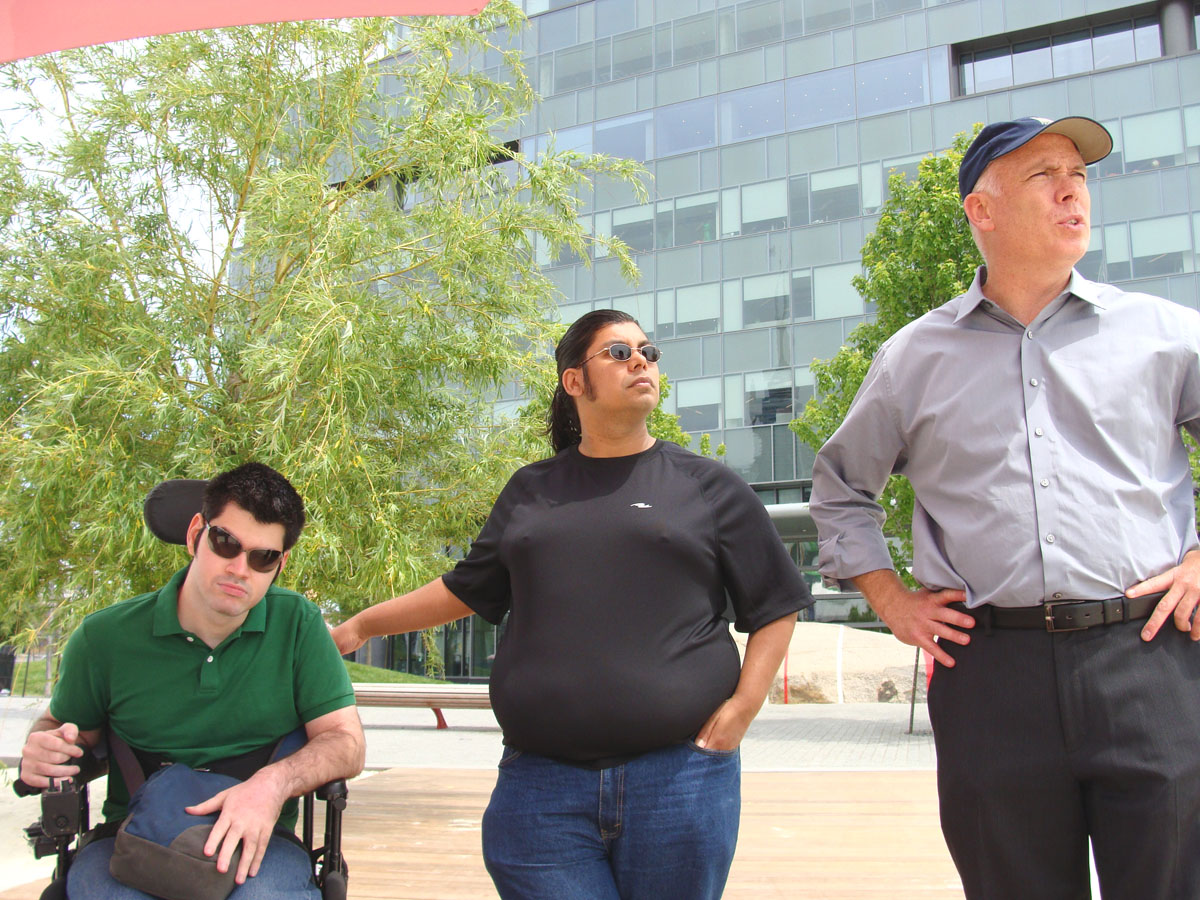Sugar Beach Accessibility Tour
Remember my attempt to get to Sugar Beach? And remember how Bruce Sudds, the Communications Manager for Waterfront Toronto wrote me an e-mail committing to making some changes? And remember that Community Planning Meeting? At that meeting, my MPP Glen Murray – who is a thoroughly decent man with a passion for universal design – suggested we do a tour of Sugar Beach to check out how Waterfront Toronto have incorporated accessibility in this project.
Forward a while. It’s now a couple of months later and the wee tour of Sugar Beach not only got scheduled last Friday, but also grew to include a number of people. Alas, Glen Murray was pulled away at the last minute, but Chris Drew from his office was there. Waterfront Toronto was represented by Bruce Sudds and James Roche, Director of Parks. Tom Davidson from Councillor McConnell’s office was there, as were Joe, the City of Toronto staff responsible for things like curb cuts and Marcus and Steve, local residents with firsthand knowledge of disability issues.
We walked down the same path as mentioned in my original post about the issue and looked at curb cuts, tripping hazards and path of access to Sugar Beach. Waterfront Toronto and the City will cooperate on fixing curb cuts that need repair and creating curb cuts on the south side of Queens Quay. As in all construction projects that require mass coordination, the timeline is a bit loose, but there should be an accessible path to Sugar Beach within the next month or two. This will be a huge relief – I have made it down there (and it is beautiful), but until the curb cuts happen, you really need someone ambulatory who can wrangle traffic as you boot along the street.
The second part of the outing was looking at Sugar Beach itself. We did have a number of able-bodied individuals along who helped us wrangle traffic and once we got there, we toured the beach. One of my favourite places is the wooden platform built out into the sand about a month ago. It enables those of us who travel seated to participate in the beach itself and The Boy and I spent a lovely couple of hours there several weeks ago. On Friday, we all traipsed out on the platform


Marcus, Steve and James Roche
We had a chat about the Muskoka chairs which are lovely, Canadian and very atmospheric, but ultimately kind of hard to get in and out of if you have mobility issues or are getting up there in years. I suggested a couple of more disability/age friendly chairs and hope some will appear. My mother and I have plans to take the Tinks to the beach and I know she won’t be able to sit in the Muskoka chairs while the kids play in the sand (when I’m advocacious, it’s also for personal reasons).
We then moved along the waterfront towards Sherbourne Common, site of a skating rink in the winter and a rollerblading-with-water area in the summer. And this is where we encountered a brilliant example of the limitations of the Ontario Building Code (OBC). There’s a small building there, home to washrooms and an eventual café. The washrooms themselves were quite well thought out, except for the automatic door button. As in most other places, it’s placed too high, which follows the OBC, but the problem is that the OBC is not only woefully inadequate, but also assumes that people in wheelchairs are able-bodied, but sitting down. This means that the people who use wheelchairs and who have limited movement in their upper body will have difficulty using or not be able to use such a button. Exiting the washrooms independently is impossible, because the buttons are placed in a corner where it can’t be reached unless you lean forward and have a full range of motion in your arms and shoulders. Which is rarely the case for people who have a disability.
This is not the fault of Waterfront Toronto. This is the fault of the OBC and I’m sure you can imagine the (polite and professional) rant that followed from the general vicinity of my person. It’s something I was up against when I used to work implementing a local municipality’s barrier-free policy in buildings, parks and policies and it’s something we’re still up against. The OBC is perpetually out of date, inadequate and lets down developers, corporations and stores like Metro who believe that following the accessibility requirements set out in the OBC will make their projects/building/store usable by people with disabilities. It doesn’t and it doesn’t serve either the developers/etc. or the consumers and customers. Retrofitting of building to fix accessibility problems after the fact is much more expensive than including usable accessibility features from the start and that means that even if developers/corporations/stores want to fix the problems, they may not be able to do it in an effective and timely fashion because of the cost. And that means continuing barriers to participation by those of us who have a disability.
Excuse the side rant. This is about Sugar Beach and Waterfront Toronto. Who at the end of the tour committed to finding a way to include consultation with people with disabilities in the Waterfront Toronto projects.
Thank you to all Chris and Tom who arranged it all, Joe for the curb cuts and Marcus and Steve for their expertise. And a special thanks to Bruce and James from Waterfront Toronto for their response, interest and commitment to making the waterfront accessible and usable to all. I’m officially impressed.
Read More
Discover what else I've been writing about...















